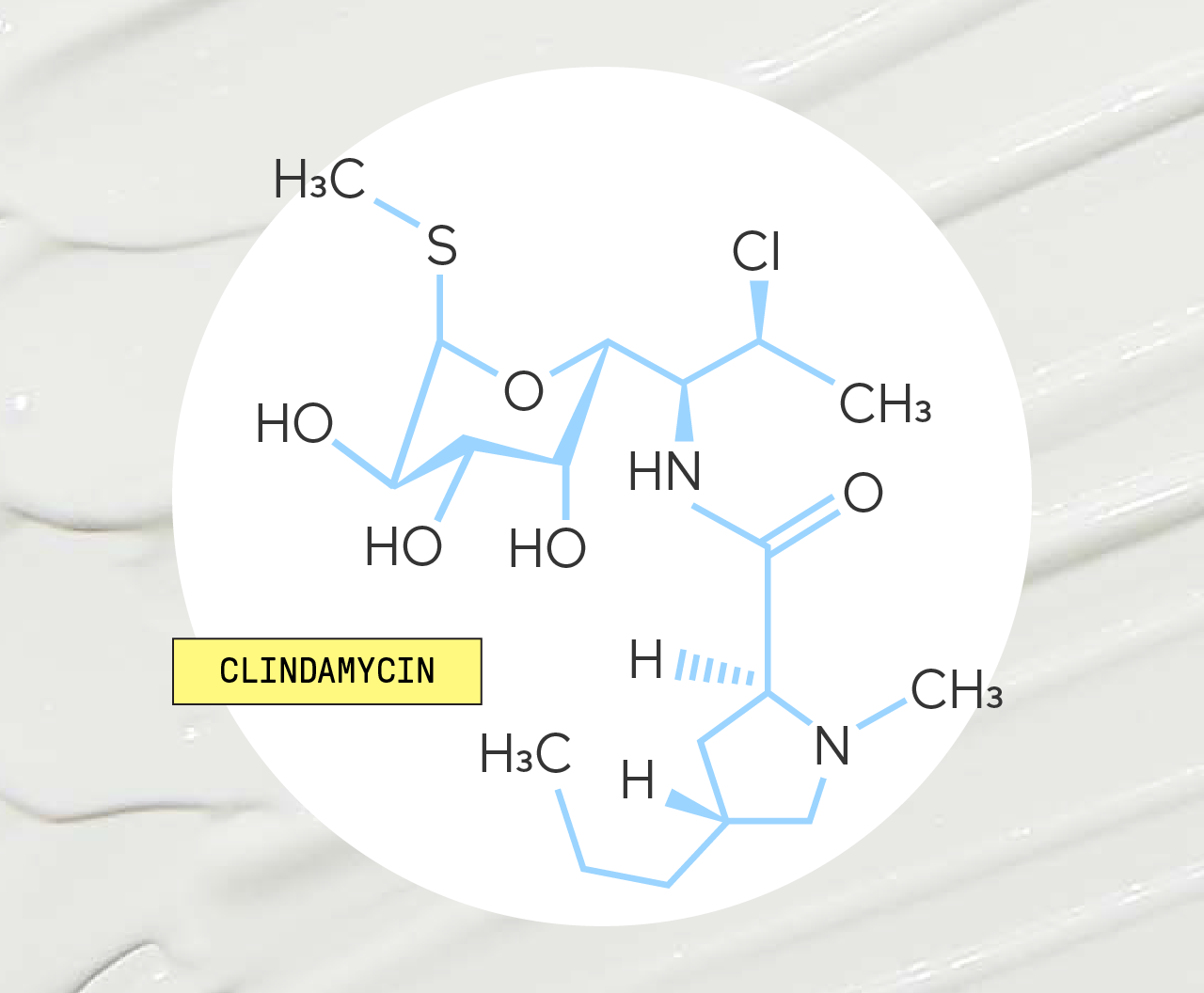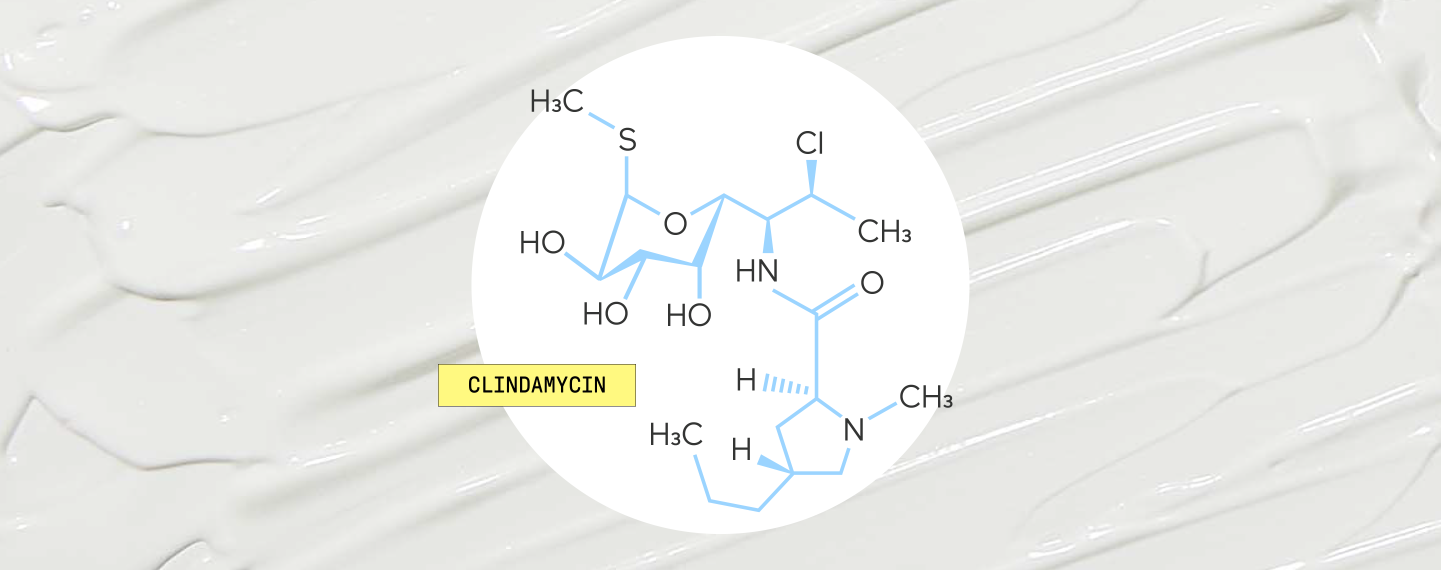Education
Clindamycin side effects


SHARE
Education
Clindamycin side effects
Medically reviewed by Katelyn Hagerty FNP
Written by Apostrophe Team
Last updated 11/3/2024
When bacterial acne gets really bad, it’s sometimes necessary to call in the big guns. One of the biggest ones on the market today is clindamycin.
Clindamycin is a prescription antibiotic designed to treat serious infections. It’s the stuff doctors depend on when you get really sick—and can be extremely beneficial when the same thing happens to your skin.
Some acne treatment labels might seem confusing, especially when they’re prescription strength. And if you’ve been prescribed clindamycin for your skin—you might be wondering about side effects.
The good news is that for most people, clindamycin is safe and effective for acne. Read on to learn more about potential clindamycin side effects, and how the medication can help clear your skin.
Quick Facts about Acne
As you might already know, acne is the result of the breakdown of normal function in your pores. The result of this breakdown is clogged pores, which can lead to acne due to the buildup of dead cells, excess oil production, and sometimes bacteria within the pores.
There are four factors that can cause an imbalance in your pores: natural oil production, dead cells you’re shedding, an inflammatory response, and bacteria (or fungi).
Pimples occur when dead skin cells fail to safely exit after they’re dismissed—and get stuck in the pore.
Dry dead cells can pile up, causing your pores to secrete more oil in an effort to get them out. Unfortunately, this oil might not work—and in turn, can create a perfect breeding ground for bacteria.
Bacterial infection can also sometimes lead to inflammation and pimples.
What Is Clindamycin and How Does It Work?
Clindamycin is an antibiotic that can be delivered in different forms to target acne in the most effective way possible.
Traditionally, the topical medication is used to treat acne, whereas the capsule form is often taken to fight serious infections of major organs like the lungs and parts of the reproductive system.
In the case of acne, clindamycin attacks the bacteria growing in and around your sebaceous glands, which produce oil for your skin.
Acne bacteria thrive in your natural oils, and targeting them where they live is the most effective way to fight them off.
Clindamycin can prevent bacteria from multiplying altogether, leading to the end of an acne outbreak.
Studies of Clindamycin for Acne
Clindamycin has an impressive track record of research, starting back in the ‘80s, where an eight-week study with more than 300 participants showed clindamycin reduced acne better than placebo.
One 12-week study in 2009 found that combining clindamycin with over-the-counter antibacterial benzoyl peroxide reduced both the frequency and severity of acne breakouts and the resulting pimples.
Another study from 2015 showed similar results. In this version, 100 young adult acne patients were split into three groups and given either a mix of the cleansing ingredient benzoyl peroxide and clindamycin, a mix of tretinoin (a retinoid) and clindamycin, or a mix of benzoyl peroxide and nadifloxacin (a topical fluoroquinolone compound).
Both clindamycin groups showed that the treatment delivered results, with the benzoyl peroxide group outperforming the tretinoin group.
Interestingly, a few years later in 2019, a study of facial acne in teens and young adults showed that clindamycin and tretinoin combined delivered “continuous improvement.”
Clindamycin Side Effects and Safety
Clindamycin is generally considered safe and effective when used according to directions, but that doesn’t mean it is without side effects.
In its oral (capsule) form, clindamycin may cause vomiting or nausea, joint pain, heartburn, pain when swallowing, unpleasant metallic tastes, thick white vaginal discharge or burning, itching or swelling of the vagina.
You should let a healthcare professional know if any of these problems are persistent or severe.
If you experience peeling, a rash, hives, itching, difficulty breathing or swallowing, swelling of the face, or decreased urination, you should consult a healthcare professional immediately, as these can be serious clindamycin side effects from the oral version.
Topical clindamycin side effects can include oily, itchy, dry, or peeling skin as well as burning sensations, new blemishes, and headaches.
Severe symptoms include bloody or watery stools, stomach cramps, and diarrhea.
Other Acne Treatments
There are a variety of treatments available for all types of acne severity, and at the most basic level, that may just look like drinking more water and cleaning up your diet.
If your pimples seem more intense than mild acne, you may want to remove excess oil with masks, blotting papers, or astringents. Removing oil can also be made easier with products like benzoyl peroxide or salicylic acid.
A reminder: Oil plays a very important role in your skin’s health by keeping dirt and other contaminants away. You do need some oil to be healthy.
Dry skin will require moisturizers. Aloe vera wins a lot of popularity contests in this regard, but hyaluronic acid has been shown to help skin retain moisture many times over its own weight.
Exfoliants are great for your skin health as well. Consider more powerful options like retinoids, which are vitamin A compounds that remove dead cells while simultaneously promoting collagen synthesis.
Stronger prescription options exist, if you need more—tretinoin has been successfully used since the ‘60s, for example, and it’s a great option with the approval of a healthcare provider.

PRESCRIPTION TRETINOIN
Target acne, dark spots, and signs of aging with this science-backed ingredient.
Be wary, though: Side effects of tretinoin can include irritation and peeling, which can be exceptionally bad for already sensitive skin.
There’s a “holistic” acne treatment worth mentioning, too, because it’s one that could improve your whole life.
Stress has been linked to acne breakouts—not to mention a whole host of other issues. Addressing stress could help your whole body. .
Beyond Clindamycin for Acne
Clindamycin is a great solution for stopping acne, as well as a host of other available acne treatment options.
Your best bet is to start your journey to healthy skin with a consultation from a healthcare provider.
In addition to prescribing medications (like clindamycin) for you, he or she will also be able to give you a specific, individualized understanding of what may be causing your acne, and mentor you through one or more treatment options as you search for the perfect fit.
If you do experience clindamycin side effects for example, a healthcare provider can help you address them and switch to another treatment option more suited to your skin.
It’s useful to remember that acne is not a one-off affliction—each person can have slightly different root cause(s) to address, and that’s only going to happen with professional help.
That said, if you still need to do a little informational reading before reaching out to someone, we’ve got you covered.
Check out this guide to the best acne spot treatments for when you get spot breakouts.
References:
Rodan, K., Fields, K., Majewski, G., & Falla, T. (2016). Skincare Bootcamp: The Evolving Role of Skincare. Plastic and reconstructive surgery. Global open, 4(12 Suppl Anatomy and Safety in Cosmetic Medicine: Cosmetic Bootcamp), e1152. https://www.ncbi.nlm.nih.gov/pmc/articles/PMC5172479/.
Yoham AL, Casadesus D. Tretinoin. [Updated 2020 Dec 5]. In: StatPearls [Internet]. Treasure Island (FL): StatPearls Publishing; 2021 Jan-. Available from: https://www.ncbi.nlm.nih.gov/books/NBK557478/.
Jegasothy, S. M., Zabolotniaia, V., & Bielfeldt, S. (2014). Efficacy of a New Topical Nano-hyaluronic Acid in Humans. The Journal of clinical and aesthetic dermatology, 7(3), 27–29. Retrieved from https://www.ncbi.nlm.nih.gov/pmc/articles/PMC3970829/.
U.S. National Library of Medicine. (n.d.). Clindamycin Topical: MedlinePlus Drug Information. MedlinePlus. https://medlineplus.gov/druginfo/meds/a609005.html.
U.S. National Library of Medicine. (n.d.). Clindamycin: MedlinePlus Drug Information. MedlinePlus. https://medlineplus.gov/druginfo/meds/a682399.html.
Ohlson, J., Dakovic, R., & Berg, M. (2019, November 21). Observational Study of Clindamycin Phosphate and Tretinoin Gel for the Treatment of Acne. JDDonline - Journal of Drugs in Dermatology. https://jddonline.com/articles/dermatology/S1545961619P0328X.
Kaur, J., Sehgal, V. K., Gupta, A. K., & Singh, S. P. (2015). A comparative study to evaluate the efficacy and safety of combination topical preparations in acne vulgaris. International journal of applied & basic medical research, 5(2), 106–110. https://www.ncbi.nlm.nih.gov/pmc/articles/PMC4456883/.
Becker, L. E., Bergstresser, P. R., Whiting, D. A., Clendenning, W. E., Dobson, R. L., Jordan, W. P., Abell, E., LeZotte, L. A., Pochi, P. E., Shupack, J. L., Sigafoes, R. B., Stoughton, R. B., & Voorhees, J. J. (1981). Topical clindamycin therapy for acne vulgaris. A cooperative clinical study. Archives of dermatology, 117(8), 482–485. Retrieved from https://pubmed.ncbi.nlm.nih.gov/6455095/.
Rathi S. K. (2011). Acne vulgaris treatment : the current scenario. Indian journal of dermatology, 56(1), 7–13. https://www.ncbi.nlm.nih.gov/pmc/articles/PMC3088940/.
Ko, H. C., Song, M., Seo, S. H., Oh, C. K., Kwon, K. S., & Kim, M. B. (2009). Prospective, open-label, comparative study of clindamycin 1%/benzoyl peroxide 5% gel with adapalene 0.1% gel in Asian acne patients: efficacy and tolerability. Journal of the European Academy of Dermatology and Venereology : JEADV, 23(3), 245–250. https://pubmed.ncbi.nlm.nih.gov/19438817/.
Kaur, J., Sehgal, V. K., Gupta, A. K., & Singh, S. P. (2015). A comparative study to evaluate the efficacy and safety of combination topical preparations in acne vulgaris. International journal of applied & basic medical research, 5(2), 106–110. https://www.ncbi.nlm.nih.gov/pmc/articles/PMC4456883/.
Acne. (n.d.). Retrieved January 28, 2021, from https://www.hopkinsmedicine.org/health/conditions-and-diseases/acne.
Mukherjee, S., Date, A., Patravale, V., Korting, H. C., Roeder, A., & Weindl, G. (2006). Retinoids in the treatment of skin aging: an overview of clinical efficacy and safety. Clinical interventions in aging, 1(4), 327–348. https://www.ncbi.nlm.nih.gov/pmc/articles/PMC2699641/.
Hoover E, Aslam S, Krishnamurthy K. Physiology, Sebaceous Glands. [Updated 2020 Oct 26]. In: StatPearls [Internet]. Treasure Island (FL): StatPearls Publishing; 2021 Jan-. Available from: https://www.ncbi.nlm.nih.gov/books/NBK499819/.
Shop this post

Clindamycin
Like what you just read? Sign up for our email list to get the scoop on skincare science delivered straight to your inbox.

Deep Dives
A dermatologist shares his thoughts on the recent studies about benzoyl peroxide and benzene.
Read More
Education
What is milia?
What is milia? Today, we’re jumping into one type of bump that you may have heard about most commonly in infants — milia.
Read More
Education
Best moisturizer for acne-prone skin
If you have combination acne-prone skin, figuring out which moisturizer is best for your skin might be tough. In this guide, we break down the best moisturizer for combination, acne-prone skin.
Read More